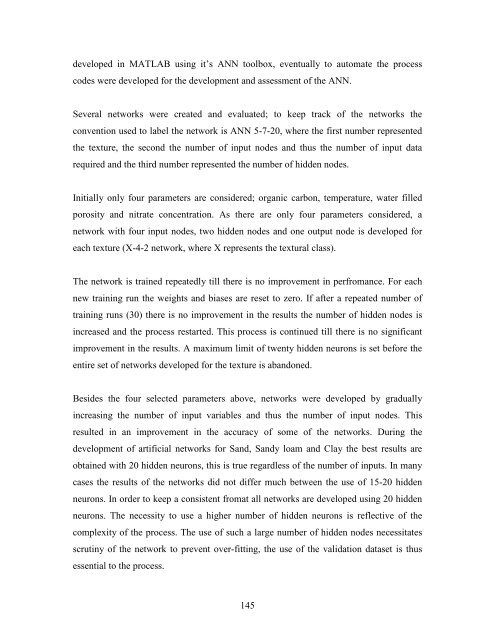THE FLORIDA STATE UNIVERSITY ARTS AND SCIENCES ...
THE FLORIDA STATE UNIVERSITY ARTS AND SCIENCES ...
THE FLORIDA STATE UNIVERSITY ARTS AND SCIENCES ...
Create successful ePaper yourself
Turn your PDF publications into a flip-book with our unique Google optimized e-Paper software.
developed in MATLAB using it’s ANN toolbox, eventually to automate the process<br />
codes were developed for the development and assessment of the ANN.<br />
Several networks were created and evaluated; to keep track of the networks the<br />
convention used to label the network is ANN 5-7-20, where the first number represented<br />
the texture, the second the number of input nodes and thus the number of input data<br />
required and the third number represented the number of hidden nodes.<br />
Initially only four parameters are considered; organic carbon, temperature, water filled<br />
porosity and nitrate concentration. As there are only four parameters considered, a<br />
network with four input nodes, two hidden nodes and one output node is developed for<br />
each texture (X-4-2 network, where X represents the textural class).<br />
The network is trained repeatedly till there is no improvement in perfromance. For each<br />
new training run the weights and biases are reset to zero. If after a repeated number of<br />
training runs (30) there is no improvement in the results the number of hidden nodes is<br />
increased and the process restarted. This process is continued till there is no significant<br />
improvement in the results. A maximum limit of twenty hidden neurons is set before the<br />
entire set of networks developed for the texture is abandoned.<br />
Besides the four selected parameters above, networks were developed by gradually<br />
increasing the number of input variables and thus the number of input nodes. This<br />
resulted in an improvement in the accuracy of some of the networks. During the<br />
development of artificial networks for Sand, Sandy loam and Clay the best results are<br />
obtained with 20 hidden neurons, this is true regardless of the number of inputs. In many<br />
cases the results of the networks did not differ much between the use of 15-20 hidden<br />
neurons. In order to keep a consistent fromat all networks are developed using 20 hidden<br />
neurons. The necessity to use a higher number of hidden neurons is reflective of the<br />
complexity of the process. The use of such a large number of hidden nodes necessitates<br />
scrutiny of the network to prevent over-fitting, the use of the validation dataset is thus<br />
essential to the process.<br />
145
















